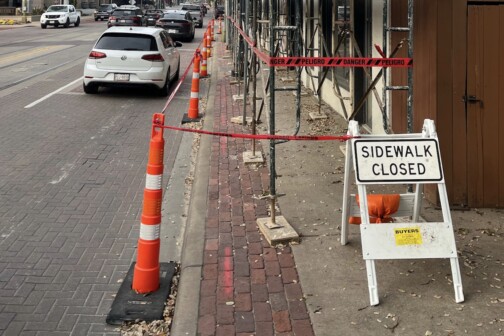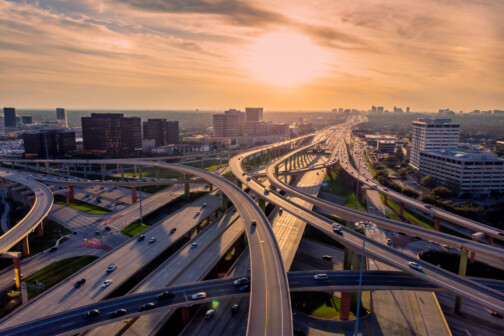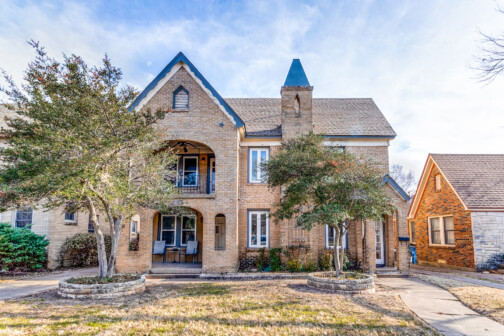A real estate consultant named Paul Carden was invited to Fair Park in late April to share an idea that is anathema to most Texans: vehicle congestion can sometimes be good.
He spoke on a stage in the Centennial Building during the EarthX conference over Earth Day weekend, not the setting one would expect for advocacy of idling vehicles. But congestion, he said, is why some neighborhoods can attract businesses and others cannot.
Carden, a vice president at real estate firm Venture Commercial, wore jeans and a blazer and spoke with the enthusiasm of a teacher who has been begging the administration for years to teach this elective. His stage partner for the afternoon was Caleb Roberts, an urban planner at a company called Gap Strategies who delivered a complementary sermon with a quick smile after each point. Roberts cued slides that showed how highways eliminate some destinations before they create others decades and miles away, by shifting congestion—and investment—to new parts of town, leaving older parts behind. On screen popped photos of the vibrant, dense 1950s-era neighborhoods just south of downtown Dallas that were later gouged by interstates 35 and 45. Then he summoned pictures of North Dallas from the same period, showing empty fields and then the businesses that filled them.
Roberts is not from Dallas, and the two had never worked together. But a mutual friend tapped them for the EarthX presentation because their messages fit: highways serve cars, not necessarily neighborhoods and the people who live in them.
The duo’s talk occurred about four weeks before the Dallas City Council gave its final vote on the future of I-345, the 1.4-mile stub of elevated highway between downtown and Deep Ellum that connects Woodall Rodgers, Central Expressway, and interstates 30 and 45. While some have advocated for tearing down the aging highway and restitching the city’s streets, others have made the case that working-class folks in South Dallas need I-345 to get to their jobs.
Carden and Roberts asked the room to look at South Dallas differently. Its western border is the Trinity River. The Great Trinity Forest is its southern boundary, and Interstate 30 is the north. Seen in its geographic context, South Dallas looks like a peninsula that should hem in traffic and draw associated development. Instead, though, I-45 and I-345 bypass the area, starving the peninsula of activity.
“The more people who travel through there, the more businesses they can have. That is opportunity. That is wealth creation,” Carden said. “But 345 is separating the traffic that would go from South Dallas and patronize those businesses and draining it to North Dallas.”
Roberts had seen this same export of vitality in his hometown, Milwaukee. The Wisconsin Department of Transportation was pushing to expand Interstate 43 through the center of the city, decades after the highway’s construction had wiped out more than 8,000 homes in a majority-Black neighborhood called Bronzeville. Roberts helped organize an effort to stop the expansion.
Years later, after moving to Dallas, he saw parallels in I-345, another urban freeway that gobbled up land and sent people and commerce elsewhere. (He now lives just a few blocks from the highway.)
South Dallas lies 2 miles east of downtown, with Fair Park near its center. Segregationist policies in the 1950s triggered White flight and brutal bombings as it became a majority Black community. Its street grid was cut in two by Interstate 30 in the 1960s, separating it physically from East Dallas. Most of its land sits in two ZIP codes, 75210 and 75215. About 21 percent of residents in 75215 have a commute of at least 35 minutes, according to the Census. In 75210, that jumps to 41 percent. The U.S. Department of Agriculture considers five of the eight Census tracts within these boundaries to be “low-income and low-access” areas, meaning lots of people in poverty who don’t have easy access to healthy food.
Meanwhile, a highway system just to its west sends 178,000 people away from South Dallas every day, according to traffic counts by the Texas Department of Transportation. “That traffic is money that is literally going right out of South Dallas on an overpass, straight into the wallets and the opportunity of those living in North Dallas,” Carden said.
Compare that to Mockingbird Lane and Inwood Road, both about 6 miles to the north. Carden told his audience that in 2019, before the pandemic changed traffic patterns, more than 43,000 cars traveled along Mockingbird each day. Inwood attracted 55,000. The busiest road in South Dallas is Robert B. Cullum Boulevard, where 25,000 cars cruise past a McDonald’s, Walgreens, and Fiesta at the edge of Fair Park, basically the only national retailers in the neighborhood. It’s also one of the few major streets in South Dallas that isn’t mirrored by the highway.
Cesar Chavez Boulevard shoots into downtown but handles barely 10,000 vehicles per day. Harwood Street also goes directly into downtown, but it accommodates only about 2,500 cars a day. Botham Jean runs along the riverfront and goes into the Cedars, carrying 11,000 cars a day.
Roberts and Carden’s argument isn’t so much that traffic counts alone will transform South Dallas or that the neighborhood needs a bunch of national chains. Instead, all those cars show what the neighborhood is up against, how easy it is for retailers to go a few miles north to what Carden calls the “path of least resistance.” In South Dallas, the lots are small and owned by many different people and companies, which can make assemblage difficult. Plus, there aren’t enough humans—on feet or in cars—to compete. So all the money just goes a few miles up the highway.
Congestion had been the buzzword at Dallas City Hall for weeks before Carden and Roberts took that stage. TxDOT needed the Council’s support for its plan to tear down I-345 and rebuild it in a trench. Organizers had prodded the state for more than a decade to study removing the freeway and replacing it with a boulevard and a reconstituted street grid, arguing that doing so would free up land for economic development and housing. Their belief is that Dallas can grow and keep housing affordable through density, that adding more people to the center of the city would create neighborhoods that won’t require long commutes.
Today, that appears unlikely. The state argued that its traffic counts showed congestion would increase by 40 to 50 percent if a boulevard were to replace the highway, a horror movie of cars and trucks crammed into four-lane city streets. Few on Council pushed back, and TxDOT got its OK to build a 10-lane freeway in a canyon.
Meantime, South Dallas still has the same economic and structural challenges after decades of segregationist policies and disinvestment. It also still has an enormous opportunity all its own.
Highway builders see those long commutes out of South Dallas as proof that residents there need the freeway to reach their jobs. Carden sees things differently. Because of the freeway, South Dallas has so much underutilized land that it could transform to accommodate new housing, jobs, and retail without ever “touching a blade of single-family,” which is by far the dominant residential style in the neighborhood.
But change is afoot in South Dallas. TxDOT recently removed a freeway that ran through the community. Martin Luther King Jr. Boulevard flew over the old U.S. 175 S.M. Wright highway. The state has removed the road and returned its right of way to at-grade, which will eventually develop into a north-south boulevard. (TxDOT was comfortable with the adjacent I-45 absorbing the traffic; I-345 doesn’t have a similar relief artery.) S.M. Wright also cut the western boundary of South Dallas in two, much like Interstate 30 did further north. The hope is that the boulevard could begin to piece the neighborhood back together.
Parking lots at Fair Park are being turned into a community park that is accessible to the neighborhood, without fencing. Of course, that is leading to what, on the surface at least, looks like a standard real estate play. A Dallas firm recently scooped up 17 buildings on Exposition Avenue, near Fair Park’s main entrance. This often leads to gentrification and displacement, with aging residents getting pushed out. A recent analysis of Zillow data found that home prices in 75215 increased more from 2016 to 2023 than all but two ZIP codes in the state.
Just down the block, however, the old neighborhood is showing signs of flickering back to life. The nonprofit Forest Forward is working to revitalize the historic Forest Theater, which was once the cultural heart of the neighborhood. The city is helping finance a specialty clinic that will take over the old Forest Hospital, one of just five Black hospitals in the 1960s.
Counteracting decades of redlining and other tools of racism will take time. And putting I-345 in a canyon will continue to siphon off money to the north. South Dallas’ best hope might be that the region’s growth creates enough congestion for everyone.
This story originally appeared in the August issue of D Magazine. Write to [email protected].
Author








